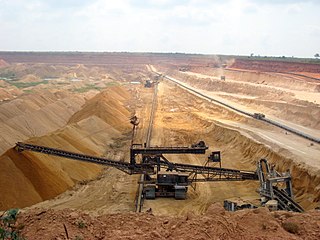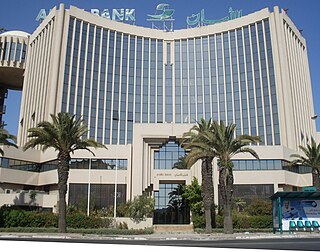Related Research Articles

The economy of Ecuador is the eighth largest in Latin America and the 69th largest in the world by total GDP. Ecuador’s economy is based on the export of oil, bananas, shrimp, gold, other primary agricultural products and money transfers from Ecuadorian emigrants employed abroad. In 2017, remittances constituted 2.7% of country's GDP. The total trade amounted to 98% of the Ecuador’s GDP in 2017.

The economy of Ghana has a diverse and rich resource base, including the manufacturing and exportation of digital technology goods, automotive and ship construction and exportation, and the exportation of diverse and rich resources such as hydrocarbons and industrial minerals. These have given Ghana one of the highest GDP per capita in West Africa. Owing to a GDP rebasement, in 2011 Ghana became the fastest-growing economy in the world.

Sri Lanka, formerly known as Ceylon, and officially the Democratic Socialist Republic of Sri Lanka, is an island country in South Asia. It lies in the Indian Ocean, southwest of the Bay of Bengal, and southeast of the Arabian Sea; it is separated from the Indian subcontinent by the Gulf of Mannar and the Palk Strait. Sri Lanka shares a maritime border with India and the Maldives. Sri Jayawardenepura Kotte is its legislative capital, and Colombo is its largest city and financial centre.

The free-market economy of Sri Lanka was worth $84 billion by nominal gross domestic product (GDP) in 2019 and $296.959 billion by purchasing power parity (PPP). The country had experienced an annual growth of 6.4 percent from 2003 to 2012, well above its regional peers. This growth was driven by the growth of non-tradable sectors, which the World Bank warned to be both unsustainable and unequitable. Growth has slowed since then. In 2019 with an income per capita of 13,620 PPP Dollars or 3,852 (2019) nominal US dollars, Sri Lanka was re-classified as a lower middle income nation by the World Bank from a previous upper middle income status.

The economy of Tanzania is a lower-middle income economy that is overwhelmingly dependent on agriculture. Tanzania's economy has been transitioning from a command economy to a market economy since 1985. Although total GDP has increased since these reforms began, GDP per capita dropped sharply at first, and only exceeded the pre-transition figure in around 2007.

The economy of Togo has struggled greatly. The International Monetary Fund (IMF) ranks it as the tenth poorest country in the world, with development undercut by political instability, lowered commodity prices, and external debts. While industry and services play a role, the economy is dependent on subsistence agriculture, with industrialization and regional banking suffering major setbacks.

The economy of Uruguay is characterized by an export-oriented agricultural sector and a well-educated workforce, along with high levels of social spending. After averaging growth of 5% annually during 1996–98, Uruguay's economy suffered a major downturn in 1999–2002, stemming largely from the spillover effects of the economic problems of its large neighbors, Argentina and Brazil. In 2001–02, Argentine citizens made massive withdrawals of dollars deposited in Uruguayan banks after bank deposits in Argentina were frozen, which led to a plunge in the Uruguayan peso, causing the 2002 Uruguay banking crisis.

The economy of Tunisia is in the process of being liberalized after decades of heavy state direction and participation in the country's economy. Prudent economic and fiscal planning have resulted in moderate but sustained growth for over a decade. Tunisia's economic growth historically has depended on oil, phosphates, agri-food products, car parts manufacturing, and tourism. In the World Economic Forum Global Competitiveness Report for 2015–2016, Tunisia ranks in 92nd place. Based on HDI latest report, Tunisia ranks 96th globally and 5th in Africa.

The economy of Guyana is the fastest growing in the world with a projected GDP growth of 26.2% in 2020. Guyana had a per capita gross domestic product of $8,300 in 2016 and an average GDP growth of 4.2% over the previous decade. Crude oil production started in 2019.

The economy of the Gambia is heavily reliant on agriculture. The Gambia has no important mineral or other natural resources, and has a limited agricultural base. About 75% of the population depends on crops and livestock for its livelihood. Small-scale manufacturing activity features the processing of peanuts, fish, and animal hides.

A developed country is a sovereign state that has a high quality of life, developed economy and advanced technological infrastructure relative to other less industrialized nations. Most commonly, the criteria for evaluating the degree of economic development are gross domestic product (GDP), gross national product (GNP), the per capita income, level of industrialization, amount of widespread infrastructure and general standard of living. Which criteria are to be used and which countries can be classified as being developed are subjects of debate. A point of reference of US$20,000 in 2021 USD nominal GDP per capita for the IMF is a good point of departure, it is a similar level of development to the United States in 1960.
The following are links to international rankings of the United States.
These are the international rankings of Pakistan.
The following are international rankings of Bangladesh.

The following are international rankings of Cuba.
The following is a list of international rankings of Belarus.
These are the international rankings of Nepal

Lesotho’s Human development index value for 2018 was 0.518 — which put the country in the low human development category — positioning it at 164 out of 189 countries and territories. Health care services in Lesotho are delivered primarily by the government and the Christian Health Association of Lesotho. Access to health services is difficult for many people, especially in rural areas. The country’s health system is challenged by the relentless increase of the burden of disease brought about by AIDS, and a lack of expertise and human resources. Serious emergencies are often referred to neighbouring South Africa. The largest contribution to mortality in Lesotho are communicable diseases, maternal, perinatal and nutritional conditions.
References
- ↑ "Coastline". cia.gov. Central Intelligence Agency. Retrieved 25 September 2021.
- 1 2 "Mid‐year Population Estimates by District & Sex, 2015 ‐ 2020". statistics.gov.lk. Department of Census and Statistics. Retrieved 1 May 2021.
- ↑ "Birth rate, crude (per 1,000 people)". worldbank.org. World Bank. Retrieved 1 May 2021.
- ↑ "Death rate, crude (per 1,000 people)". worldbank.org. World Bank. Retrieved 1 May 2021.
- ↑ "Fertility rate, total (births per woman)". worldbank.org. World Bank. Retrieved 1 May 2021.
- ↑ "Life expectancy and Healthy life expectancy, data by country". World Health Organization. 2020.
- ↑ "Population growth (annual %)". worldbank.org. World Bank. Retrieved 1 May 2021.
- ↑ "Mortality rate, under-5 (per 1,000 live births)". worldbank.org. World Bank. Retrieved 1 May 2021.
- ↑ "Economic and Social Statistics of Sri Lanka 2020" (PDF). cbsl.gov.lk. Central Bank of Sri Lanka. Retrieved 1 May 2021.
- ↑ "World Population Prospects 2019, custom data acquired via website". population.un.org. United Nations, Department of Economic and Social Affairs, Population Division. Retrieved 1 May 2021.
- 1 2 3 4 "World Economic Outlook Database, April 2021". IMF.org. International Monetary Fund . Retrieved 1 May 2021.
- ↑ "World Economic Outlook Database, April 2021". IMF.org. International Monetary Fund. Retrieved 1 May 2021.
- ↑ "Ease of Doing Business rankings". doingbusiness.org. World abnk. Retrieved 1 May 2021.
- ↑ "Country Rankings". heritage.org. The Heritage Foundation. Retrieved 1 May 2021.
- ↑ "The Global Competitiveness Report 2019" (PDF). weforum.org. World Economic Forum. 2019. Retrieved 1 May 2021.
- ↑ "Global Innovation Index 2020" (PDF). Cornell University, INSEAD, World Intellectual Property Organization. Retrieved 1 May 2021.
- ↑ "Gini index (World Bank estimate)". worldbank.org. World Bank. Retrieved 1 May 2021.
- ↑ "Democracy Index 2020". The Economist. 2020. Retrieved 1 May 2021.
- ↑ "Corruption Perceptions Index". transparency.org. Transparency International. Retrieved 1 May 2021.
- ↑ "2021 World Press Freedom Index". Reporters Without Borders. 2020. Retrieved 1 May 2021.
- ↑ "2020 Global Peace Index" (PDF). Institute for Economics & Peace. 2020. Retrieved 1 May 2021.
- ↑ "Fragility in the World 2020". The Fund for Peace. 2020. Retrieved 1 May 2021.
- ↑ "Sri Lanka". worldjusticeproject.org. World Justice Project. Retrieved 25 September 2021.
- ↑ "Global Gender Gap Report 2021" (PDF). weforum.org. World Economic Forum. Retrieved 25 September 2021.
- ↑ "Sri Lanka". freedomhouse.org. Freedom House. Retrieved 25 September 2021.